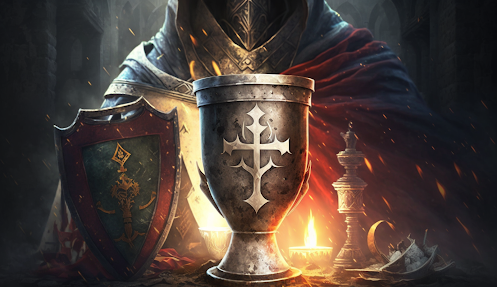The Enigma of the Holy Grail: A Christian Mystery Uncovered
Introduction:
The Holy Grail has captured the imagination of people for centuries, inspiring countless tales, legends, and works of art. As one of the most iconic Christian mysteries, the Grail has become synonymous with the quest for divine wisdom and enlightenment. But what exactly is the Holy Grail, and why has it become the subject of such intrigue and fascination? In this article, we will delve into the origins, legends, and enduring allure of the Holy Grail, seeking to uncover the truth behind this enigmatic relic.
Origins of the Holy Grail:
The Holy Grail's origins are shrouded in the mists of time, and its true nature remains a subject of debate among scholars, theologians, and archeologists. One widely held theory is that the Grail is the chalice used by Jesus Christ during the Last Supper, which was later used by Joseph of Arimathea to collect Jesus' blood at the Crucifixion. This sacred vessel is believed to possess miraculous powers and has come to symbolize the divine wisdom and redemption offered by Christ's sacrifice.
Legends and Texts:
The Grail's lore has been woven into the tapestry of Western literature and popular culture, appearing in works such as the Arthurian legends and the medieval romance 'Perceval, the Story of the Grail.' These tales, often imbued with elements of chivalry, adventure, and spiritual growth, have perpetuated the Grail's status as an object of eternal fascination.
In the Arthurian cycle, the quest for the Holy Grail becomes a central theme, with the Knights of the Round Table embarking on an arduous journey to find the sacred vessel. The Grail quest serves as a metaphor for the spiritual journey, highlighting the trials and tribulations faced by the individual in pursuit of divine truth and self-realization.
The Connection with the Knights Templar:
The enigmatic Knights Templar, a medieval Christian military order, have also been linked to the Holy Grail. Founded in 1119, the order was entrusted with the protection of Christian pilgrims traveling to the Holy Land. The Templars' close ties to the Church, their secretive nature, and their alleged wealth have fueled speculation that they may have discovered and guarded the Grail. While no concrete evidence supports this theory, it has nevertheless contributed to the mystique surrounding the Holy Grail.
Modern-Day Pursuits:
The enduring appeal of the Holy Grail has led to numerous modern-day quests for the elusive relic. Archeologists, historians, and treasure hunters have searched far and wide, from the remote corners of Europe to the deserts of the Middle East, in the hope of unearthing the Grail. Although many intriguing artifacts and possible Grail sites have been discovered, the definitive location and nature of the Holy Grail continue to elude us.
Conclusion:
The Holy Grail remains one of Christianity's most enduring mysteries, a symbol of divine wisdom and redemption that has captivated the human imagination for centuries. As we continue to unravel the legends, texts, and theories surrounding this enigmatic relic, we are reminded of the timeless quest for spiritual growth and enlightenment at the heart of the Grail's allure. Whether or not the Holy Grail is ever discovered, its profound influence on our culture and collective consciousness is undeniable.



Comments
Post a Comment